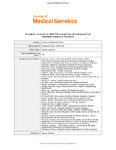Bi-allelic variants in WNT7B disrupt the development of multiple organs in humans
| dc.contributor.author | Baptista, Julia | |
| dc.date.accessioned | 2022-06-29T16:03:40Z | |
| dc.date.issued | 2022-07-05 | |
| dc.identifier.issn | 0022-2593 | |
| dc.identifier.issn | 1468-6244 | |
| dc.identifier.uri | http://hdl.handle.net/10026.1/19357 | |
| dc.description.abstract |
BackgroundPulmonary hypoplasia, Diaphragmatic anomalies, Anophthalmia/microphthalmia and Cardiac defects delineate the PDAC syndrome. We aim to identify the cause of PDAC syndrome in patients who do not carry pathogenic variants in RARB and STRA6, which have been previously associated with this disorder.MethodsWe sequenced the exome of patients with unexplained PDAC syndrome and performed functional validation of candidate variants.ResultsWe identified bi-allelic variants in WNT7B in fetuses with PDAC syndrome from two unrelated families. In one family, the fetus was homozygous for the c.292C>T (p.(Arg98*)) variant whereas the fetuses from the other family were compound heterozygous for the variants c.225C>G (p.(Tyr75*)) and c.562G>A (p.(Gly188Ser)). Finally, a molecular autopsy by proxy in a consanguineous couple that lost two babies due to lung hypoplasia revealed that both parents carry the p.(Arg98*) variant. Using a WNT signalling canonical luciferase assay, we demonstrated that the identified variants are deleterious. In addition, we found that wnt7bb mutant zebrafish display a defect of the swimbladder, an air-filled organ that is a structural homolog of the mammalian lung, suggesting that the function of WNT7B has been conserved during evolution for the development of these structures.ConclusionOur findings indicate that defective WNT7B function underlies a form of lung hypoplasia that is associated with the PDAC syndrome, and provide evidence for involvement of the WNT–β-catenin pathway in human lung, tracheal, ocular, cardiac, and renal development. | |
| dc.format.extent | 294-300 | |
| dc.format.medium | Print-Electronic | |
| dc.language | en | |
| dc.language.iso | en | |
| dc.publisher | BMJ Publishing Group | |
| dc.subject | human genetics | |
| dc.title | Bi-allelic variants in WNT7B disrupt the development of multiple organs in humans | |
| dc.type | journal-article | |
| dc.type | Journal Article | |
| dc.type | Research Support, Non-U.S. Gov't | |
| plymouth.author-url | https://www.webofscience.com/api/gateway?GWVersion=2&SrcApp=PARTNER_APP&SrcAuth=LinksAMR&KeyUT=WOS:000821477000001&DestLinkType=FullRecord&DestApp=ALL_WOS&UsrCustomerID=11bb513d99f797142bcfeffcc58ea008 | |
| plymouth.issue | 3 | |
| plymouth.volume | 60 | |
| plymouth.publication-status | Published | |
| plymouth.journal | Journal of Medical Genetics | |
| dc.identifier.doi | 10.1136/jmedgenet-2022-108475 | |
| plymouth.organisational-group | /Plymouth | |
| plymouth.organisational-group | /Plymouth/Faculty of Health | |
| plymouth.organisational-group | /Plymouth/Faculty of Health/Peninsula Medical School | |
| plymouth.organisational-group | /Plymouth/Users by role | |
| plymouth.organisational-group | /Plymouth/Users by role/Academics | |
| dc.publisher.place | England | |
| dcterms.dateAccepted | 2022-06-11 | |
| dc.rights.embargodate | 2022-7-12 | |
| dc.identifier.eissn | 1468-6244 | |
| rioxxterms.versionofrecord | 10.1136/jmedgenet-2022-108475 | |
| rioxxterms.licenseref.uri | http://www.rioxx.net/licenses/all-rights-reserved | |
| rioxxterms.type | Journal Article/Review |


